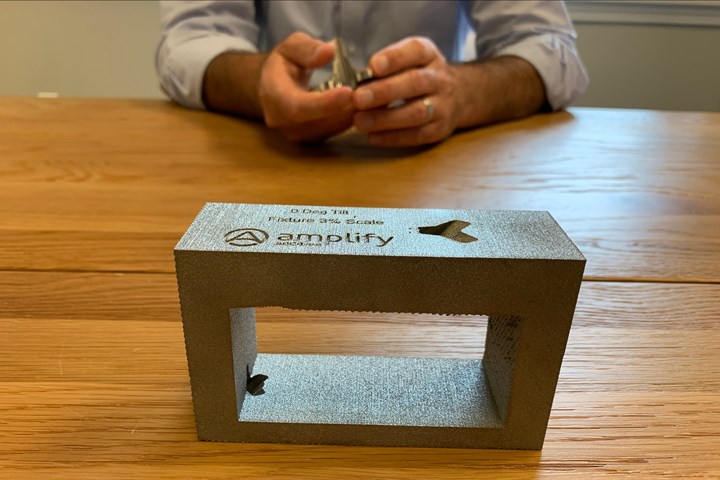Why Was This Block 3D Printed? To Help With Machining
This manufacturer making medical implants through additive manufacturing simplifies the machining by 3D printing the workholding fixture along with the parts.
Share





This fixture tool for holding additive manufactured parts for machining was made within the same additive manufacturing build as the parts themselves.
Production metal parts made via additive manufacturing (AM) generally need CNC machining as a secondary step. The metal removal needs might be slight, such as threaded holes and precise mating surfaces, but the machining can be difficult nevertheless because of the challenge of holding and positioning the organic-shaped additive part.
Amplify Additive had this challenge with orthopedic implants made via electron beam melting (or EBM, a metal AM technology supplied by GE Additive). More accurately, the machining supplier had this challenge. Engineering setups to hold the complex parts Amplify sent it would introduce lead time delay. In one extreme case (partly a result of disruption related to covid), Amplify faced months of lead time for machining work from this shop, making the lead time advantage of AM moot.
To help, Amplify has begun to design and 3D print the fixture tooling for machining in parallel with the implants and provide both to the machine shop. The photo shows an example. The long stem of an implant fits through the precise opening in the top face of this block and is secured within the notch in the inner corner. The visible “3%” figure refers to these features being oversize by that amount relative to the AM part. This margin, plus the positioning of these features, orients the part precisely to present the surface in need of machining to the milling spindle.
This seemingly simple tool also shows off some of the advantages of electron beam melting, which is a high-temperature AM process compared to more common laser power bed metal AM. The greater heat reduces thermal stress, making it easier to print a square form like this that is useful for setup on a machine tool. Also, EBM is a process with less need for support structures than laser powder bed fusion, which in this case allowed Amplify to simply add the printing of this tool within the volume of an additive builds, and send the tool to the machine shop in its as-printed form.
Related Content
-
Toolpath Improves Chip Management for Swiss-Type Lathes
This simple change to a Swiss-type turning machine’s toolpath can dramatically improve its ability to manage chips.
-
Orthopedic Event Discusses Manufacturing Strategies
At the seminar, representatives from multiple companies discussed strategies for making orthopedic devices accurately and efficiently.
-
How to Troubleshoot Issues With Tool Life
Diagnosing when a tool is failing is important because it sets an expectation and a benchmark for improvements. Finding out why gives us a clue for how to fix it.
















.jpg;maxWidth=300;quality=90)





